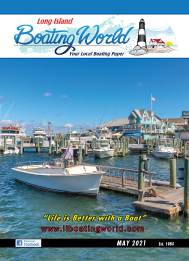
Advanced Nav Rules, Part 2 of 3 … Inland and International Navigation Rules …The current Inland Navigation Rules were established in the1980’s. These were defined by the 1982 United Nations Convention on the Law of the Sea. Inland Navigation Rules apply to waters that are 12 nautical miles out to sea from the mean low-water mark of a coastal state (country). In addition, each coastal state may claim a contiguous zone adjacent to and beyond its territorial sea that extends seaward up to 24 nm from its baselines. Finally, the US created an Exclusive Economic Zone (EEZ) which extends further seaward for 200 additional nautical miles beyond the 12 nautical mile territorial sea of the U.S. These zones also apply in the Commonwealth of Puerto Rico, Guam, American Samoa, the U.S. Virgin Islands, and the Commonwealth of the Northern Mariana Islands. In The United States, these rules are enforced by the Coast Guard. Vessel Priority … Did you know that all vessels are not created equality? Starting from the bottom of the totem pole each vessel listed must keep out of the way of all vessels above their position. 7. Seaplanes … 6. Power -Driven … 5. Sailing (not motor-sailing, which is considered power-driven under the rules) … 4. Engaged in Fishing … 3. Constrained by Draft … 2. Restricted in Ability to Maneuver … 1. Not Under Command.
The Shape I’m In … Day Shapes … This boating safety tip focuses on Day Shapes. These as shapes displayed on commercial boats and sailboats operating under power. They are used during daylight hours when visibility is not restricted. Day Shapes are made of either plastic that is coated with black vinyl, or black colored metal mesh. Each shape mimics specific commercial lights that go beyond the minimally required standard lights. It is important for all boaters to know what the day shapes are signaling so they understand what type of vessels are in near proximity to their boats, and what precautions are prudent to ensure safety. The descriptions that follow are a selection of the important Day Shape configurations that are required on commercial boats. For the complete list consult the Coast Guard Navigation Rules book that is available at most marine supply stores. In all cases day shapes are in used during clear weather conditions. If visibility becomes restricted, the advanced lights that are in addition to standard lighting requirements for recreational boats are used. A. Not Under Command … This is a vessel that has stopped because it cannot navigate according to the rules due to a mechanical malfunction. It would show only two black ball day shapes on the masthead. If this vessel could get underway if would add standard lighting. B. Restricted in Ability to Maneuver … This vessel is restricted in her ability to change course due to the nature of her work. It will show a black ball over a black diamond over a second black ball on the mast. C. Towing Astern … When towing, the tug will and the barges will show black diamond shapes. If the towed vessels are partly submerged each one will show a black diamond forward and aft. D. Vessel Pushing Ahead, that is Part of a Composite Unit. … A tug pushing a barge as a composite unit does not need to show a day shape. E. A Tug Pushing Ahead on Western Rivers Above the Huey P. Long Bridge … For reasons not specified in the rules, masthead lights are not required when pushing ahead on this part of the Mississippi River. In this case day shapes are not required. F. A Vessel Trawling … A vessel trawling will show two black cones apexes together on the masthead so long as visibility is not restricted. G. A Vessel Fishing Other Than Trawling … A vessel that is fishing other than trawling will also display two black cones apexes together. As with the vessel trawling, all other standard lights will be shown if visibility becomes restricted H. A Vessel Dredging … A vessel that is dredging will display two black balls in a vertical line to depict the side of the vessel where the dredge is operating. On the opposite side of the vessel you will see two black diamonds in a vertical line. This two black diamond side is where it is safe to proceed. In restricted visibility standard lights will be shown. I. A Mine Clearing Vessel at Work … If you come upon a ship showing one black at the masthead that forms a triangle with black balls (one on each end of the yardarm) you have come upon a vessel clearing mines. J. Sailing Under Power … A black cone apex down on the mast is shown. Boating Safety Classes … 45 states in the US require boaters to take safe boating classes which cover the basic inland navigation rules for recreational boaters. These classes are very good. They are available in live lecture, and online formats. However, these basic classes do not include rules that specifically apply to commercial vessels. The broader set of rules include requirements for lights, shapes, and whistles that identify a commercial vessel’s mission, configuration, and operational status. Smart skippers know the importance of knowing what ships are in near proximity of their vessel. To find online State Boating Safety Courses go to Helpful Resources in Captain Stormalong’s Tall Tale Blog @ boatopsandsafety.com. Congratulations … You have navigated through The Shape I’m In. Part three … Whistle Me a Tune will address sound signals. All serious skippers should have a clear understanding the sights and sounds used by commercial ships. Smart Boating is Safe Boating.
